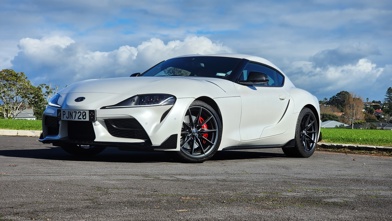If there is one single marque that is utterly synonymous with the term “gran turismo” (or “grand tourer” in English) then it is quite definitely Maserati.
The Italian company’s first cars were GTs (with the A6 1500 from 1947 literally being named the Gran Turismo) and the company has generally had one or more (2 seaters, 2+2 seaters or 4 seaters) in its line up ever since then.

Iconic names like Khasmin, Kyalami, Mistral and Shamal have featured over the years, while in 1998 Maserati launched one of the most successful cars of its recent history, the 3200 GT, which was also, of course, a GT.
The 3200 GT gave way to the Coupe (and Spyder convertible) in 2001, which evolved into the GranTurismo (and GranCabrio) in 2007. The GranTurismo stayed in production until 2019 until there was a small gap before the all-new version debuted recently.

And now it has landed in New Zealand, with the first examples touching down here for a special customer reveal event held at Hampton Downs.
A GT at a race track? Yeah, well that is a large part of what has made Maserati GTs so special - the fact that they are equally at home blasting through a European mountain pass or hammering around a race circuit on a track day.

And guess what - it turns out that the new GranTurismo is just as at home on a race track as well. While the GranCabrio hasn’t quite arrived yet (it’s on its way) and the all-electric GranTurismo Folgore is following shortly, we only experienced the GranTurismo in both Modena and top-spec Trofeo form.
The GranTurismo shares its platform with the Grecale SUV and its V6 engine with the mighty MC20 supercar, albeit in a detuned guise, so all models feature the excellent “Nettuno” 3.0-litre twin-turbo V6 driving all four wheels via an 8-speed automatic transmission, as well as 20-inch alloy wheels on the front and 21s on the rear.

The Modena opens the range with a 360kW/600Nm version of the V6, while the Trofeo adds more aggressive front and rear spoilers, carbon fibre side skirts and, most importantly, a 405kW/650Nm version of the Nettuno V6.
Topping the range will be the Folgore, an all electric version of the GranTurismo that packs three 300kW electric motors that translates into a hefty 560kW and 1350Nm. But that is not quite here yet, so for now the petrol versions will have to do. Fortunately, they do that and much, much more.

On track in the GranTurismo
Starting out in the Modena, the first thing you notice is how the car shrinks around you as you manoeuvre it out onto the Hampton Downs track. Make no mistake, at 4959mm long, the GranTurismo is most certainly not a small car, but it never feels particularly large on the track.

This is helped by the GranTurismo’s relatively svelte weight of 1795kg. While not light by sports car standards, it actually weighs the same as the RWD Aston Martin DB12 and 100kg less than the AWD BMW M8.
But the impressive thing is that it actually feels far lighter than that on the track. The GranTurismo is remarkably agile and responsive, with surprisingly sharp and precise reactions to inputs, whether it be throttle or steering.
The steering is wonderfully accurate, with authoritative turn-in and excellent feel, while the AWD chassis has what initially feels like an infinite amount of mechanical grip. That is until you decide it doesn't need it, and a healthy stab of the throttle will see it become what feels like a proper front-engined, RWD car with plenty of power, and the rear end happily steps out to whatever degree you require of it, be it a cheeky little wiggle or a majestic drift.
Drive it on a track with an eye to speed and accuracy, and the GranTurismo is a wonderfully responsive and thoroughly satisfying tool that effortlessly carves up corners. Get a bit more showy with it and the rear end becomes delightfully playful, while the front remains glued to the surface, tracking with remarkable tenacity and letting the rear end to show off to its (or your) heart’s content.
How much better is the Trofeo?
Jumping into the Trofeo it is easy to think “just how much better can this actually be?”, as things look and feel remarkably similar, but fire it up and you immediately get an inkling.
While the Modena has an intoxicating rumble that sounds much more like a big block V8 than a relatively compact and high-strung turbo V6, the Trofeo adds a sharp and aggressive edge to it that instantly gets you interested.
Nail the throttle and it gets even more interesting, as the extra 45kW makes itself instantly known and the noticeably firmer Trofeo belts off the line. This theme continues out on the track, as the Trofeo proves itself to be noticeably sharper, and feel even lighter and more agile than the Modena, despite weighing the same.
The Trofeo basically focuses on upping everything that is sporty and track-oriented about the Modena, but theoretically without sacrificing any of its luxurious road-going GT attributes.
I say “theoretically” because we didn’t drive either on the road, but I came away with the distinct feeling that, while the Trofeo was exhilarating on the track, the Modena may well prove to be the better choice, simply because it was almost as good on the track, but will likely be the easier and more luxurious option to live with in daily life.
That is until the Folgore arrives, as overseas reports suggest that it is ferociously fast and even more serenely luxurious, thanks to its all-electric powertrain, while also remaining impressively agile.
Still, the sound of a serious high-performance engine plays a big part in the emotional response to a GT, and both the Modena and Trofeo deliver that and more in an impressively luxurious package that also happens to be remarkably good fun on a race track.





